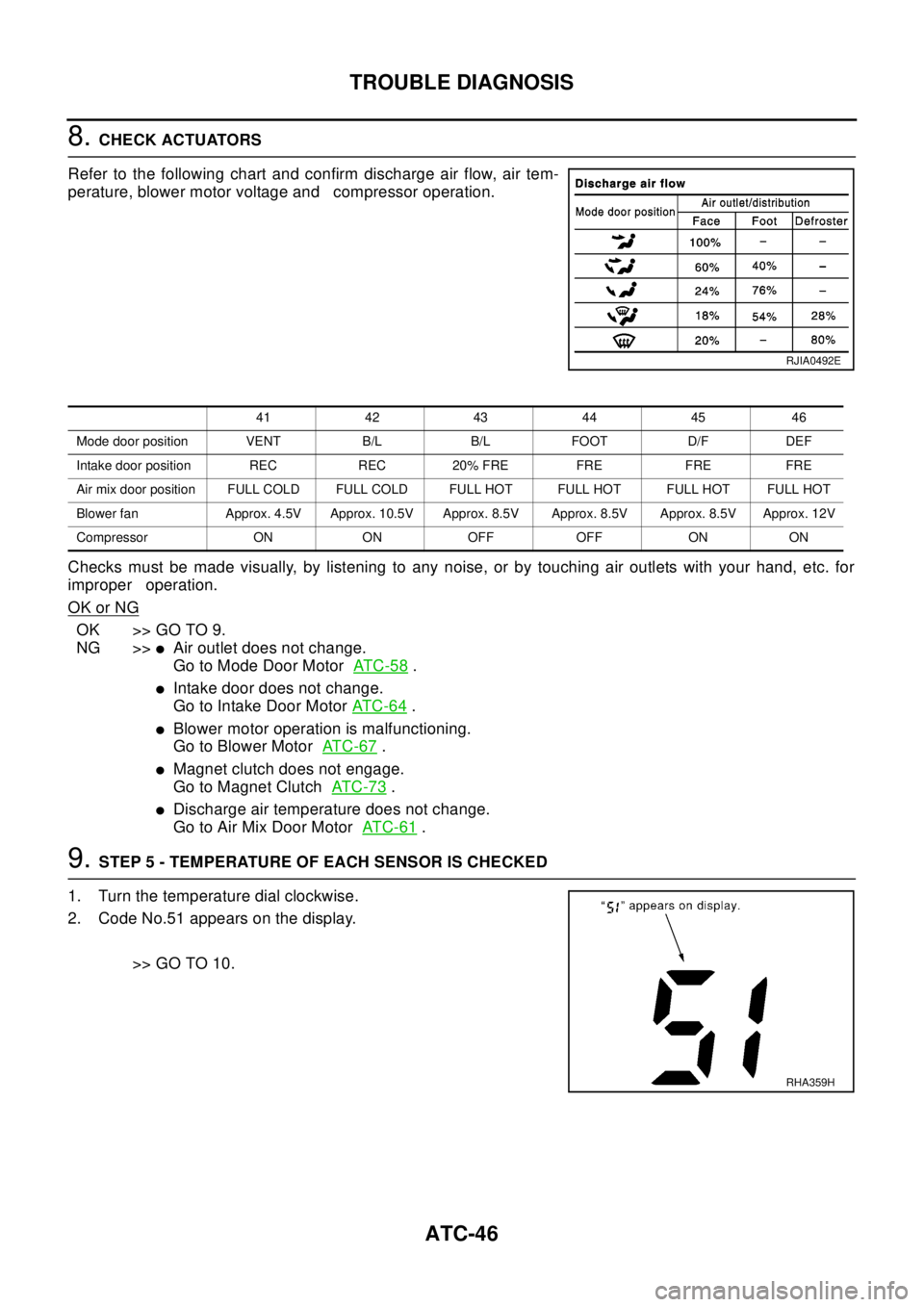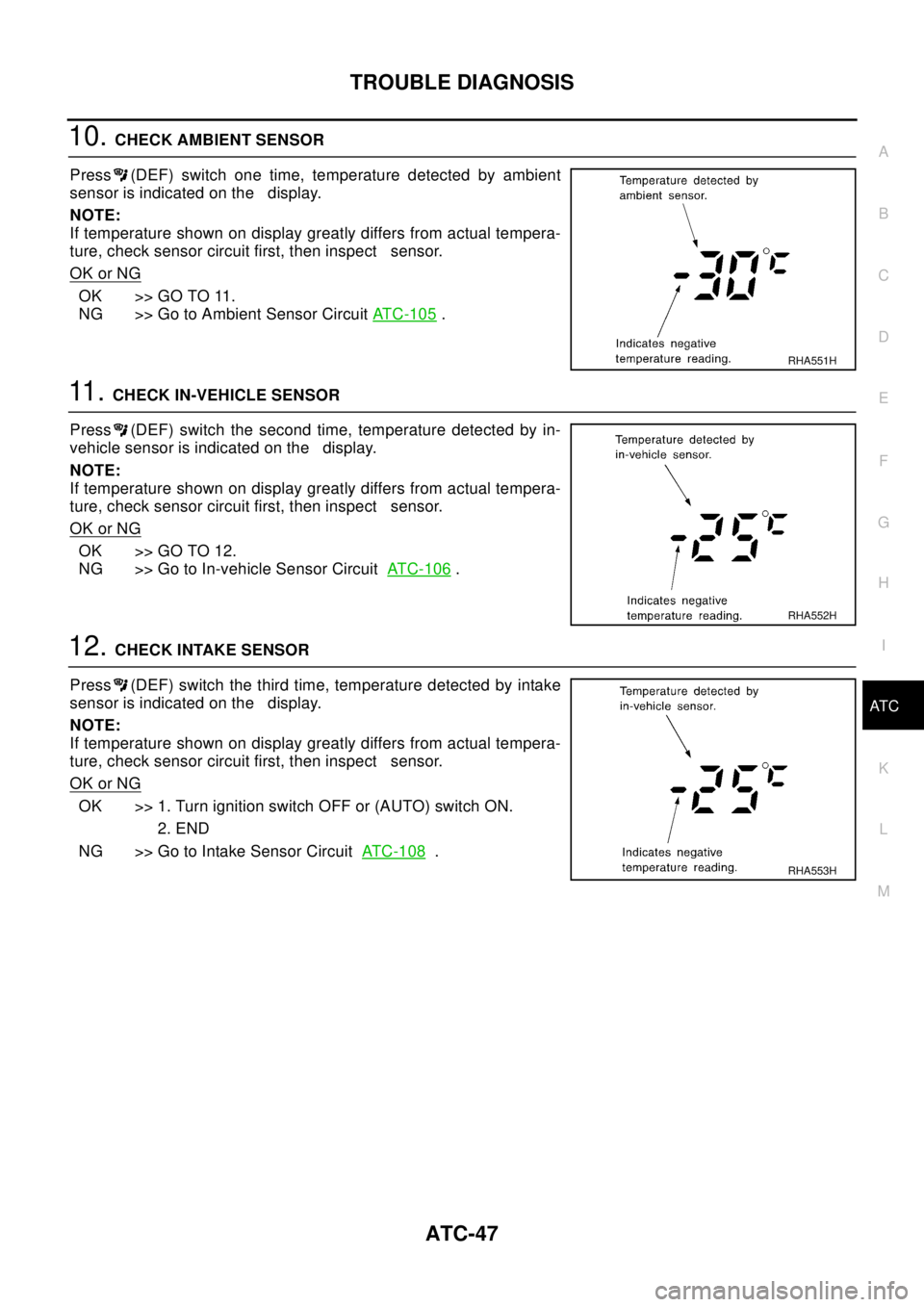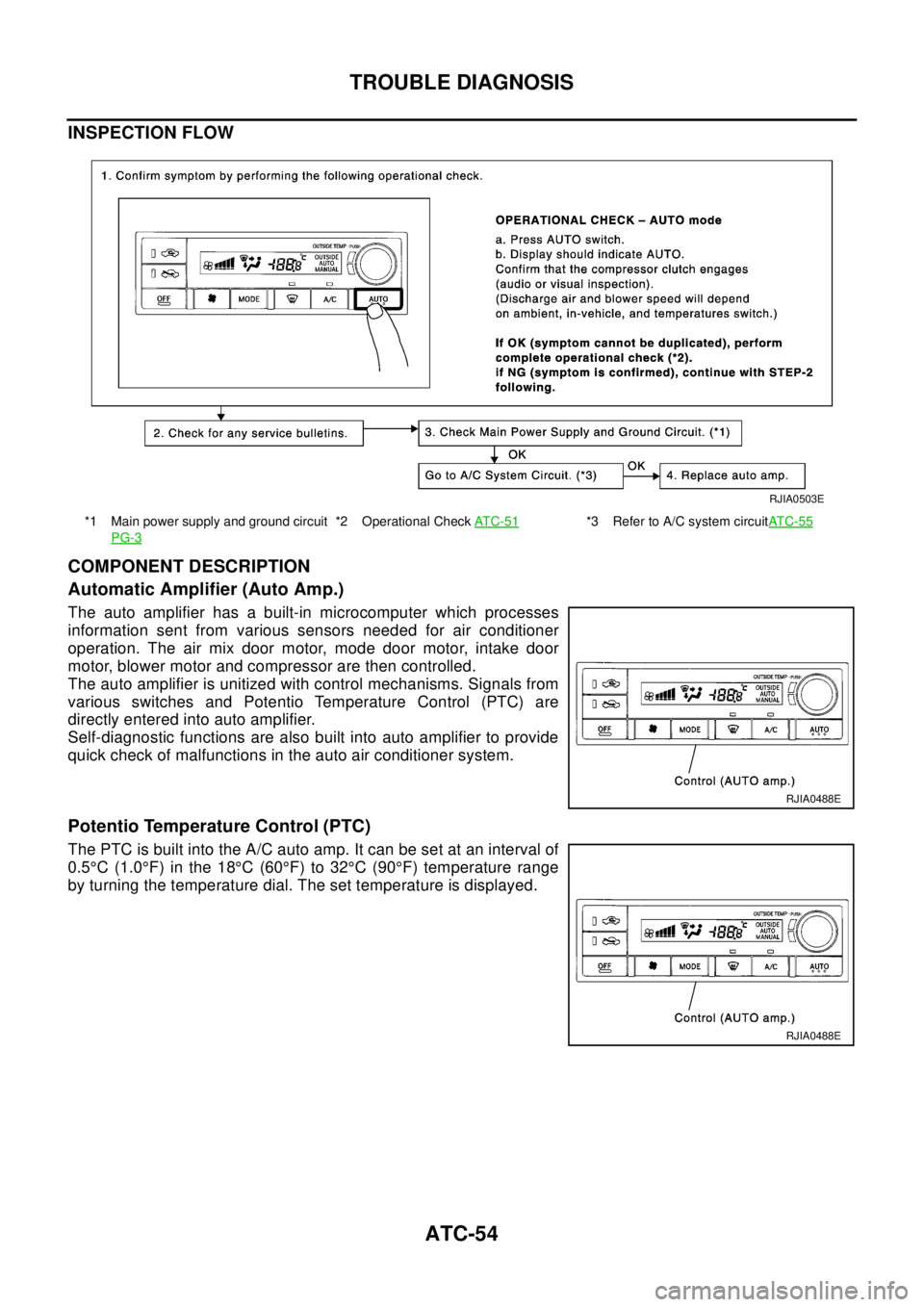Page 620 of 3066

ATC-42
TROUBLE DIAGNOSIS
Self-diagnosis Function
EJS001GX
DESCRIPTION
The self-diagnostic system diagnoses sensors, door motors, blower motor, etc. by system line. Refer to appli-
cable sections (items) for details. Shifting from normal control to the self-diagnostic system is accomplished
by starting the engine (turning the ignition switch from OFF to ON) and pressing OFF switch for at least 5
seconds. The "OFF" switch must be pressed within 10 seconds after starting the engine (ignition switch is
turned ON). This system will be canceled by either pressing A/C switch or turning the ignition switch OFF.
Shifting from one step to another is accomplished by means of turning temperature dial, as required.
17Fan control amp. control
signalIGN
ONFan speed: 1st, 2nd, 3rd, 4th Approx. 2.5 - 3.5
Fan speed: 5th Approx. 9.0
18 Blower motor feed backIGN
ONFan speed: 1st Approx. 8.0
19 Fan ON signalIGN
ONBlower fan: ON Approx. 0
Blower fan: OFF Approx. 4.8
20 Power supply for ACCIGN
ON-Approx.12
21With gasoline engine:
Water temperature sensorIGN
ON-
With diesel engine:
Thermal transmitterIGN
ONWater temperature: 56°C Approx. 5.67 - 7.01
24 Sensor groundIGN
ON-Approx.0
25 Intake sensor - - -
30Compressor feed back sig-
nal (With gasoline engine)IGN
ON-Approx.0
Disconnect the refrigerant pressure sensor
connectorApprox. 5 TERMI-
NAL NO.ITEM CONDITIONVo ltag e
(V)
SKIA0056J
Page 622 of 3066
ATC-44
TROUBLE DIAGNOSIS
2.STEP 1 - LEDS AND DISPLAY ARE CHECKED
Check LEDs illuminate and display screen.
Ye s o r N o
Yes >>GOTO3.
No >> Malfunctioning OFF switch or LEDs.
>> Replace A/C auto amp.
3.CHECK TO ADVANCE SELF-DIAGNOSIS STEP 2
1. Turn the temperature dial clockwise.
2. Advance to self-diagnosis STEP 2?
Ye s o r N o
Yes >>GOTO4.
No >> Malfunctioning temperature dial.
>> Replace A/C auto amp.
4.CHECK TO RETURN SELF-DIAGNOSIS STEP 1
1. Turn the temperature dial counterclockwise.
2. Return to self-diagnosis STEP 1?
Ye s o r N o
Yes >>GOTO5.
No >> Malfunctioning temperature dial.
>> Replace A/C auto amp.
5.STEP 2 - SENSOR CIRCUITS ARE CHECKED FOR OPEN OR SHORT CIRCUIT
1. Turn the temperature dial clockwise.
2. Does code No.20 appear on the display?
Ye s o r N o
Yes >>GOTO6.
No >> GO TO 13.
RJIA0491E
RHA970DB
Page 624 of 3066

ATC-46
TROUBLE DIAGNOSIS
8.CHECK ACTUATORS
Refer to the following chart and confirm discharge air flow, air tem-
perature, blower motor voltage and compressor operation.
Checks must be made visually, by listening to any noise, or by touching air outlets with your hand, etc. for
improper operation.
OK or NG
OK >> GO TO 9.
NG >>
lAir outlet does not change.
Go to Mode Door MotorAT C - 5 8
.
lIntake door does not change.
Go to Intake Door MotorAT C - 6 4
.
lBlower motor operation is malfunctioning.
Go to Blower MotorAT C - 6 7
.
lMagnet clutch does not engage.
Go to Magnet ClutchAT C - 7 3
.
lDischarge air temperature does not change.
Go to Air Mix Door MotorAT C - 6 1
.
9.STEP 5 - TEMPERATURE OF EACH SENSOR IS CHECKED
1. Turn the temperature dial clockwise.
2. Code No.51 appears on the display.
>> GO TO 10.
RJIA0492E
41 42 43 44 45 46
Mode door position VENT B/L B/L FOOT D/F DEF
Intake door position REC REC 20% FRE FRE FRE FRE
Air mix door position FULL COLD FULL COLD FULL HOT FULL HOT FULL HOT FULL HOT
Blower fan Approx. 4.5V Approx. 10.5V Approx. 8.5V Approx. 8.5V Approx. 8.5V Approx. 12V
Compressor ON ON OFF OFF ON ON
RHA359H
Page 625 of 3066

TROUBLE DIAGNOSIS
ATC-47
C
D
E
F
G
H
I
K
L
MA
B
AT C
10.CHECK AMBIENT SENSOR
Press (DEF) switch one time, temperature detected by ambient
sensor is indicated on the display.
NOTE:
If temperature shown on display greatly differs from actual tempera-
ture, check sensor circuit first, then inspect sensor.
OK or NG
OK >> GO TO 11.
NG >> Go to Ambient Sensor CircuitAT C - 1 0 5
.
11 .CHECK IN-VEHICLE SENSOR
Press (DEF) switch the second time, temperature detected by in-
vehicle sensor is indicated on the display.
NOTE:
If temperature shown on display greatly differs from actual tempera-
ture, check sensor circuit first, then inspect sensor.
OK or NG
OK >> GO TO 12.
NG >> Go to In-vehicle Sensor CircuitATC-106
.
12.CHECK INTAKE SENSOR
Press (DEF) switch the third time, temperature detected by intake
sensor is indicated on the display.
NOTE:
If temperature shown on display greatly differs from actual tempera-
ture, check sensor circuit first, then inspect sensor.
OK or NG
OK >> 1. Turn ignition switch OFF or (AUTO) switch ON.
2. END
NG >> Go to Intake Sensor CircuitAT C - 1 0 8
.
RHA551H
RHA552H
RHA553H
Page 626 of 3066
ATC-48
TROUBLE DIAGNOSIS
13.CHECK MALFUNCTIONING SENSOR
Refer to the following chart for malfunctioning code No.
(If two or more sensors malfunction, corresponding code Nos. blink respectively two times.)
*1:Conduct self-diagnosis STEP 2 under sunshine.
When conducting indoors, aim a light (more than 60W) at sunload sensor, otherwise Code No.25 will indicate
despite that sunload sensor is functioning properly.
*2:AT C - 1 0 5
.
*3:AT C - 1 0 6
.
*4:AT C - 1 0 8
.
*5:AT C - 1 0 7
*6:AT C - 6 1
>> INSPECTION END
Code No. Malfunctioning sensor (Including circuits) Reference page
21 / -21 Ambient sensor *2
22 / -22 In-vehicle sensor *3
24 / -24 Intake sensor *4
25 / -25 Sun-load sensor *5
26 / -26 Air mix door motor (LCU) PBR *6
RJIA0493E
Page 632 of 3066

ATC-54
TROUBLE DIAGNOSIS
INSPECTION FLOW
COMPONENT DESCRIPTION
Automatic Amplifier (Auto Amp.)
The auto amplifier has a built-in microcomputer which processes
information sent from various sensors needed for air conditioner
operation. The air mix door motor, mode door motor, intake door
motor, blower motor and compressor are then controlled.
The auto amplifier is unitized with control mechanisms. Signals from
various switches and Potentio Temperature Control (PTC) are
directly entered into auto amplifier.
Self-diagnostic functions are also built into auto amplifier to provide
quick check of malfunctions in the auto air conditioner system.
Potentio Temperature Control (PTC)
The PTC is built into the A/C auto amp. It can be set at an interval of
0.5°C(1.0°F) in the 18°C(60°F) to 32°C(90°F) temperature range
by turning the temperature dial. The set temperature is displayed.
*1 Main power supply and ground circuit
PG-3*2 Operational CheckAT C - 5 1*3 Refer to A/C system circuitAT C - 5 5
RJIA0503E
RJIA0488E
RJIA0488E
Page 637 of 3066
TROUBLE DIAGNOSIS
ATC-59
C
D
E
F
G
H
I
K
L
MA
B
AT C
INSPECTION FLOW
*1 Discharge air flowAT C - 2 8*7 Sunload sensor circuitAT C -9 8*13 Symptom tableAT C - 3 0
*2 Operational checkAT C -5 1*8 Air mix door motor circuitAT C -6 1*14 Intake sensor circuitAT C - 1 0 8
*3 Self-diagnosisAT C - 4 2, see No.1 *9 Self-diagnosisAT C - 4 2,seeNo.14
*4 Self-diagnosisAT C - 4 2
, see No. 5 *10 LAN system circuitAT C -4 2
*5 Ambient sensor circuitAT C - 9 3*11 Component description for Mode door
AT C -6 1
*6 In-vehicle sensor circuitAT C - 9 5*12 Operational checkAT C - 5 1
RJIA0512E
Page 638 of 3066

ATC-60
TROUBLE DIAGNOSIS
SYSTEM DESCRIPTION
Component Parts
Mode door control system components are:
lAuto amp.
lMode door motor (LCU)
lA/C LAN system (PBR built-in air mix door motor, mode door motor and intake door motor)
lIn-vehicle sensor
lAmbient sensor
lSunload sensor
lIntake sensor
System Operation
The auto amplifier receives data from each of the sensors. The amplifier sends air mix door, mode door and
intake door opening angle data to the air mix door motor LCU, mode door motor LCU and intake door motor
LCU.
The air mix door motor, mode door motor and intake door motor read their respective signals according to the
address signal. Opening angle indication signals received from the auto amplifier and each of the motor posi-
tion sensors are compared by the LCUs in each motor with the existing decision and opening angles. Subse-
quently, HOT/COLD or DEFROST/VENT or FRESH/RECIRCULATION operation is selected. The new
selection data is returned to the auto amplifier.
Mode Door Control Specification
RHA045HA
RHA384HA